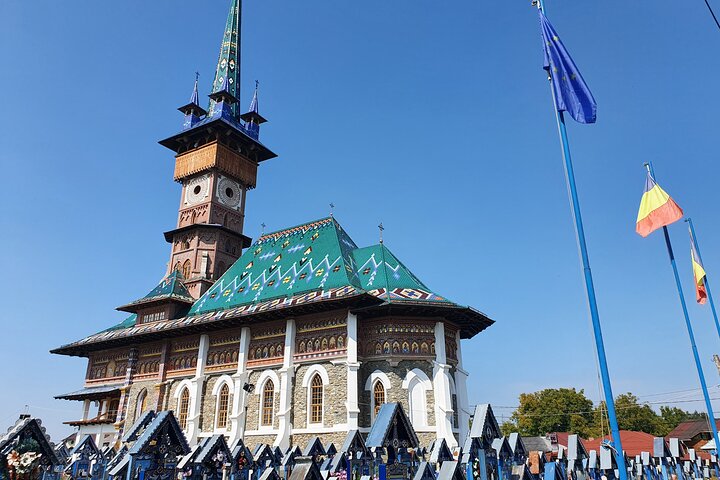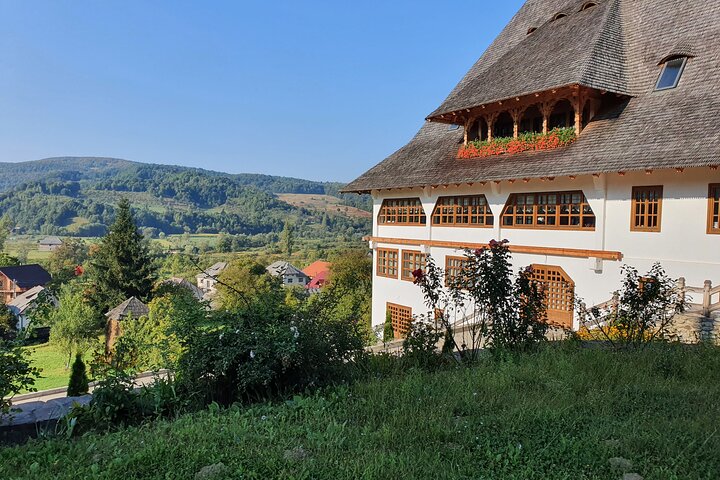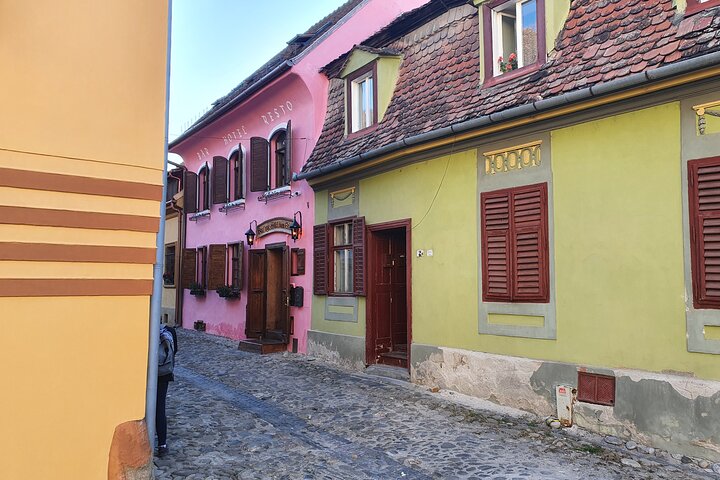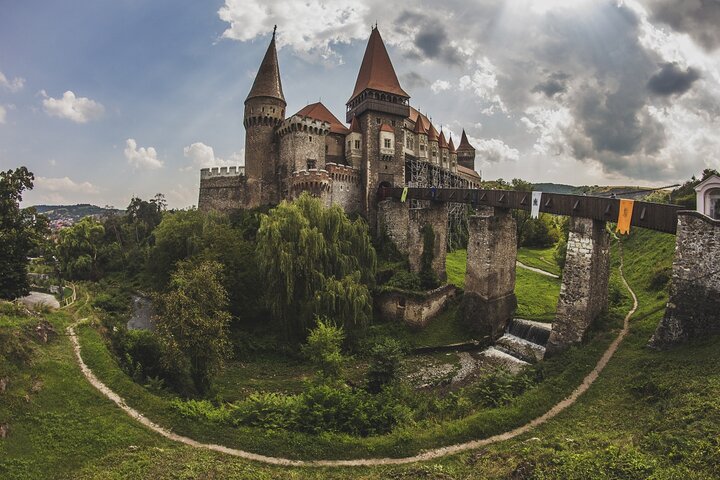Embark on an 8-day adventure through Romania, exploring medieval sites, immersing in wilderness, and indulging in traditional food. Experience the rich culture and natural beauty of Romania while enjoying funny stories and understanding the locals.
Embark on an 8-day adventure through Romania, exploring medieval sites, immersing in wilderness, and indulging in traditional food. Experience the rich culture and natural beauty of Romania while enjoying funny stories and understanding the locals.
1. Curtea de Arges Monastery 2. Poenari Castle 3. Transfagarasan Highway 4. Sibiu City Tour - Overnight stay in Sibiu
Curtea de Arges Monastery - Did you know that Curtea de Arges is unique for the important royal tombs it hides?
Everyone knows that truly good, beautiful and durable things come only through sacrifice, which will become apparent…
1. Curtea de Arges Monastery 2. Poenari Castle 3. Transfagarasan Highway 4. Sibiu City Tour - Overnight stay in Sibiu
Curtea de Arges Monastery - Did you know that Curtea de Arges is unique for the important royal tombs it hides?
Everyone knows that truly good, beautiful and durable things come only through sacrifice, which will become apparent when you reach the old town of Curtea de Arges. With a rich and eventful history, this is where you get to see the ruins of the Wallachian princely court, the 13th century Royal Church, as well the famous Arges Monastery, an important historical monument with an interesting, yet sad story.
Poienari Castle - The ruins of Poienari Fortress stand high on a cliff overlooking the Arges River, at the foothills of the Carpathian Mountains. Built at the beginning of the 13th century by the first Walachian rulers, the castle changed names and residents a few times over the decades; eventually, it was abandoned and left in ruins.
recognized the potential of the location and upon taking over the throne, he ordered that the structure be repaired and consolidated, turning it into one of his main fortresses. When the Turks attacked and captured the castle in 1462, Vlad escaped via a secret passageway leading north through the mountains.
Big Square (Piata Mare) - If you are in Transylvania, Sibiu is a must visit travel destination with a history of 900 year. A city tour to help you understand why Sibiu was elected as the European Capital of Culture, it includes the Evangelical Cathedral, the Sibiu Old City Center and the town itself, which are among the most visited tourist attractions in Romania, because they cater to every taste and provide a wonderful travelling experience for even the pickiest of tourists.
If you love authentic cultural experiences, whether you are more romantic or more adventurous, here you will find everything you need to relax and enjoy yourself, leave the stress of your everyday life behind, and have a fun and memorable trip.
The beauty of this old citadel, having received record-breaking recognition, stems from its architecture, the arrangement of the streets, its cultural and artistic heritage, and its beautiful natural scenery, as the town is flanked on two sides by the mountains Fagaras and Lotru.
1. Turda Salt mine 2. Cluj Napoca 3. Surdesti Wooden Church - Overnight in Sighetul Marmatiei (Maramures)
Salina Turda - This place is a feast for the eyes and the body, as your lungs will be very grateful for the purifying saline air, beneficial especially for those with respiratory problems, such as allergies or asthma.
You will discover vestiges of Roman heritage, as salt mining in the area goes back thousands of years. You will get the chance to see the former Iosif, Terezia, and Rudolf mines, and medieval salt exploitation machinery unique in Europe – the hardware, the crivac (or gepel), the salt mill, as well as an altar carved in the salt wall and the “Stairway of the Rich”, with its intricate woodwork.
Gradina Botanica “Alexandru Borza” - If you pass through Transylvania during your trip to Romania, a Cluj Napoca City Tour should definitely be on your itinerary. Get your camera ready, because the Old City Center features a number of unique historical and architectural monuments, Baroque, Renaissance and Gothic-style buildings, the oldest of which date back to the 17th century, as well as friendly and welcoming people.
Not to mention the restaurants and the delicious local cuisine, which are so popular that you might have to wait in line before you can get a table and enjoy your meal.
Surdesti Wooden Church - Nothing compares to the characteristic warmth that wooden constructions exude, but the Surdesti church has a lot more going for it. People who see it are so awe-stricken they tip their hats off – not exactly a joke, considering the church’s towers measures an impressive 54 meters.
Imagine the kind of artwork and craftsmanship that must have gone into this 72-meter high wooden gem, a difficult task even with modern day technology, and when you think it was built in 1721, you can understand why it is considered an architectural masterpiece.
1. Explore a local market 2. Merry Cemetery 3. Sighet Memorial Museum - Overnight in Sighetul Marmatiei (Maramures)
Merry Cemetery - We have mentioned history, culture and adventure, but this trip to Romania is also guaranteed to include some fun.
Dacians, our brave and wise ancestors who worshiped the god Zalmoxis, would laugh at funerals and cry when babies were born.
Here in Maramures you can still find traces of historical continuity, most notably in Sapanta, home of the one and only Merry Cemetery.
The crosses and tombstones, each a skillful and colorful work of art, bear humorous poems about the deceased that will have you in stitches.
Sapanta-Peri Monastery - Sapanta Peri Monastery is one of the most representative churches for Maramures. Located next to Sapanta Village, within a dendrology park, the wooden church was built in 1391. In 1391 Dragos Voda’s nephews donated lands and properties to Peri Monastery, so they built a stone church. For 312 years, the Romanian Diocese of Maramures used the stone church as its headquarters. Back then, the Monastery had the Archangel Michael (Sfantul Arhanghel Mihail) as the patron saint.
Memorial of the Victims of Communism and of the Resistance - If you want to know why the Romanian people fought so hard to escape the communist oppression, pay a visit to the Memorial Museum for the Victims of Communism and you will only begin to understand how damaging the totalitarian regime was and how much pain and suffering it brought in such a short time.
1. Barsana Monastery 2. Borgo Pass Road 3. Ciocanesti Village - Overnight in Gura Humorului
Barsana Monastery - One of the tallest wooden church in Romania (57m height)
In the same way you feel the eternal, primordial connection with the earth when you walk barefoot through the grass, you will experience a spiritual connection with the sky and God as you step into the courtyard of the most beautiful wooden monastery in Romania, the Barsana Monastery.
If you think you have seen astonishing places before, of such divine beauty that you felt they were a piece of heaven on earth, this trip to Maramures might have you reconsider.
With its fairytale scenery and timeless history, this magical place has fascinated both tourists and locals for hundreds of years.
Tihuța Pass - Tihuta pass or Borgo Pass is located in the north part of the country, making it possible to cross the Bârgău mountains from Moldavia to Transylvania. The pass is located at 1201m, between Măgura Calului peak(1229m) Piatra Fântânele mountain(1067m). This road has been built first between 1812-1817 at the initiative of the Council of War of the Austro-Hungarian Army. In 1969 the road was first paved and afterwards asphalted. Usually the traffic on the road is quite crowded, you might get stuck behind trucks on the way, but fortunately there aren’t many villages on the course of the road, so the crusing speed is acceptable. The road conditions are very good, the asphalt being in optimal shape. The road is twisty, having many wide curves that will put a smile on your face. Make sure you don’t get caugh up in the moment and forget to stop and admire the beautiful views.
Ciocanesti - A village in Northern Romania is one of the most colorful destinations in Europe, according to famous travel guide Lonely Planet.
In a feature story called Places that pop: 10 of Europe’s most colourful destinations, Lonely Planet writer Tamara Sheward has complied a list of “vibrant villages, technicolour towns and dazzling districts” tourists should visit, and the Ciocanesti commune in Suceava county, Northern Romania, is on it.
“Carpathian Mountains. The very name conjures up images of vampires, werewolves and bewitched forests. But in the historic Bucovina region, Ciocanesti busts every spooky cliché: after all, what could be less terrifying than an entire village painted like Easter eggs?,” reads the presentation.
1. Voronet Monastery 2. Sucevita M. 3. Moldovita M. 4. Humor M. 5. Egg Paineted Museum - Overnight in Gura Humorului
Manastirea Voronet - The Voroneț Monastery is a medieval monastery in the Romanian village of Voroneț, now a part of the town Gura Humorului. It is one of the famous painted monasteries from southern Bukovina, in Suceava County.[1] The monastery was constructed by Stephen the Great in 1488 over a period of 3 months and 3 weeks to commemorate the victory at Battle of Vaslui. Often known as the “Sistine Chapel of the East”, the frescoes at Voroneț feature an intense shade of blue known in Romania as “Voroneț blue.”[1]
Did you know that Voronet Monastery was founded by Stephen the Great?
Dubbed as the “Sistine Chapel of the East”, it attracts tens of thousands of tourists from around the world every year, having at least three unique elements that make it one of the highlights of your trip through Moldavia and Bucovina.
The most impressive aspect of the church’s artwork, both on the inside and on the outside, is the exceptional background color – the famous Voronet blue!
Humor Monastery - In order to understand how important religion has been for our people, you have to take a tour of Romania and see the sheer number of houses of worship that have been built, but also destroyed by enemies over the course of history.
Striving to protect their spiritual treasures, people erected churches away from the eyes of the world, some of them hidden in the depths of the woods, others nestled within rock caves at high altitudes.
Humor Monastery, which was built approximately 500 years ago, is an example of a fortified monastery that has managed to endure over the centuries.
After the first church that stood here, built around 1400, was destroyed, the second one, built in 1530 with thick river rock walls, was meant to be a place of worship that would withstand the test of time.
Sucevita Monastery - Sucevita and Voronet are two of THE MOST BEAUTIFUL ROMANIAN MONASTERIES, part of the international cultural and spiritual patrimony, which is why they should be included in any trip to Romania and northern Moldavia.
Even if you have not read the Bible, or the Book of Books, the biblical scenes and icons painted on the walls of the Sucevita Monastery will give you a stunning and vivid visual support in understanding the history of Christianity.
The fortified church is like an open book for anyone who enters its doors, and only once you see it in person will you truly understand why it was included on the UNESCO World Heritage list of cultural landmarks.
Moldovita Monastery - If you want to take a spiritual journey to a place that still echoes with the fervent prayers of the hundreds of thousands of people that have found solace here over the course of history, take your adventure through the Carpathians and Balkans to one of the oldest monastic settlements in Romania, built in 1532, home of the Moldovita Monastery.
The fortified church combines elements of Byzantine, Gothic and Moldavian style, but what truly impresses visitors is its unique mural artwork, on both the inside and the outside of this beautiful house of worship.
1. Bicaz Gorge 2. Nicolae Popa Museum 3. Red Lake - Overnight in Sighisoara
Bicaz Canyon - The gorge was excised by the waters of the river Bicaz and it serves as a passageway between the Romanian provinces of Moldova and Transylvania.
It is a noted location to see the wallcreeper, an uncommon cliff-dwelling bird.
The road along the 8 kilometres of ravines, often in serpentines with rock on one side and a sheer drop on the other, is one of the most spectacular drives in the country. Also within the gorge is Lacul Roșu (the Red Lake), with its traditional cabins, hotels, and its famous lake (situated at 980m altitude) caused by a landslide in the 19th century.
Cheile Bicazului is one of the main rock climbing sites in Romania.
The Popa Museum - 12 kilometers away from Targu Neamt, in Tarpesti, Neamt County, you can visit an interesting and notable sight, Nicolae Popa Museum. The museum was founded in the ‘70s by the local sculptor Nicolae Popa, in his own house.
After being wounded in the Second World War, imprisoned by the communists for fighting against the regime and left without any personal possessions besides his house, Nicolae Popa decided to stand out for the Romanian values. With hard work and commitment, driven by a strong native inclination for art, he becomes one of the most valued and appreciated naive sculptors in Romania and a true creator of folklore.
1. Sighisoara City Tour 2. Viscri Village 3. Brasov City Tour - Overnight in Brasov
Sighisoara Clock Tower - We start the tour of Sighisoara Old Town and we’ll have the chance to visit Clock Tower, and Arms museum. If you want to go back in time and catch a glimpse of what life was like in the Middle Ages, you absolutely have to visit Sighisoara, Romania’s medieval town, and Count Dracula’s (actually, Vlad the Impaler) place of birth.
Built in 1280, the Sighisoara Citadel is not just one of the most visited tourist attractions in Romania, it is a living, breathing medieval fortress, since it has remained inhabited for over 700 years – which is quite rare.
Village de Viscri - With a history that goes back to the 12th century, Viscri is maybe the most famous village in Romania. Prince Charles’ visits, its fortified church, and the activity of the Mihai Eminescu Trust helped this small village reinvent itself in the past years. Its promotion was such a success that Viscri is right now one of Transylvania’s must-see attractions.
Piaka Sfatului - The Council Square (Piața Sfatului in Romanian, former Marktplatz in German, Főtér or Tanács tér in Hungarian) is located in the historic centre of Brașov, Romania.[1] It obtained its right to hold markets in 1520, but it has been the place for weekly and annual markets since 1364, being visited by merchants from the country and abroad.[citation needed] It is surrounded by 18th-19th century houses, most of which are historical monuments.
1. Bran Castle 2. Peles Castle 3. Sinaia Monastery - Back to Bucharest
Bran Castle (Dracula’s Castle) - Bran Castle, between myth and history..
Because his fictional portrayal of Dracula’s castle matches Bran so closely, it is widely believed that Bram Stoker must have used descriptions of it to create the fictitious home of Count Dracula.
Outside the castle, you’ll have the chance to try an array of traditional foods: handmade cheeses, pálinka (plum and pear brandy), and traditionally-produced ham and sausages.
Peles Castle - Once upon a time there was a beautiful castle…
If have decided to write your memoirs or you want to brag about having seen the most beautiful castles in Europe, the Romanian royal family’s summer residence is, by far, one of the most important tourist attractions in Romania and in Europe, and you will soon understand why.
Every year, thousands of important figures and hundreds of thousands of tourists book tours of Romania for this attraction alone, to admire its beauty and at least for a few hours, feel like royalty.
Manastirea Sinaia - The Sinaia Monastery, located in Sinaia, in Prahova County, Romania, was founded by Prince Mihail Cantacuzino in 1695 and named after the great Saint Catherine’s Monastery on Mount Sinai in Egypt. As of 2005, it is inhabited by 13 Christian Orthodox monks led by hegumen Macarie Boguș. It is part of the Bucharest archdiocese.

- Exclusive private car (Tourism or Minibus) for your group
- Tailored hotel recommendations to fit your budget
- Private, licensed English-speaking guide/driver throughout the tour
- Complimentary Wi-Fi in the car for a comfortable journey
- Guide’s accommodation, meals, and entrance fees included
- All car expenses covered, including gasoline, parking,…
- Exclusive private car (Tourism or Minibus) for your group
- Tailored hotel recommendations to fit your budget
- Private, licensed English-speaking guide/driver throughout the tour
- Complimentary Wi-Fi in the car for a comfortable journey
- Guide’s accommodation, meals, and entrance fees included
- All car expenses covered, including gasoline, parking, and tolls
- Flexible itinerary with the option for changes during the tour
- Accommodation, meals and beverages
- Entrance fees as per the itinerary
- Accommodation, meals and beverages
- Entrance fees as per the itinerary
This 8-day exploration of Romania promises an adventure like no other. We’ve handpicked a diverse array of experiences that will engage all your senses, from visiting age-old medieval sites to experiencing the untamed beauty of Romania’s lush forests filled with vivid wildflowers and crisp mountain air (depending on the season). The journey doesn’t stop…
This 8-day exploration of Romania promises an adventure like no other. We’ve handpicked a diverse array of experiences that will engage all your senses, from visiting age-old medieval sites to experiencing the untamed beauty of Romania’s lush forests filled with vivid wildflowers and crisp mountain air (depending on the season). The journey doesn’t stop there, we’ve incorporated modern exhibits and the savory tastes of traditional foods, seasoned with local herbs and spices from every medieval town on our itinerary. Expect a good deal of travelling interspersed with amusing tales - it’s the perfect way to dive into the heart of Romania and its people!
For a full refund, cancel at least 24 hours before the scheduled departure time.
For a full refund, cancel at least 24 hours before the scheduled departure time.
























